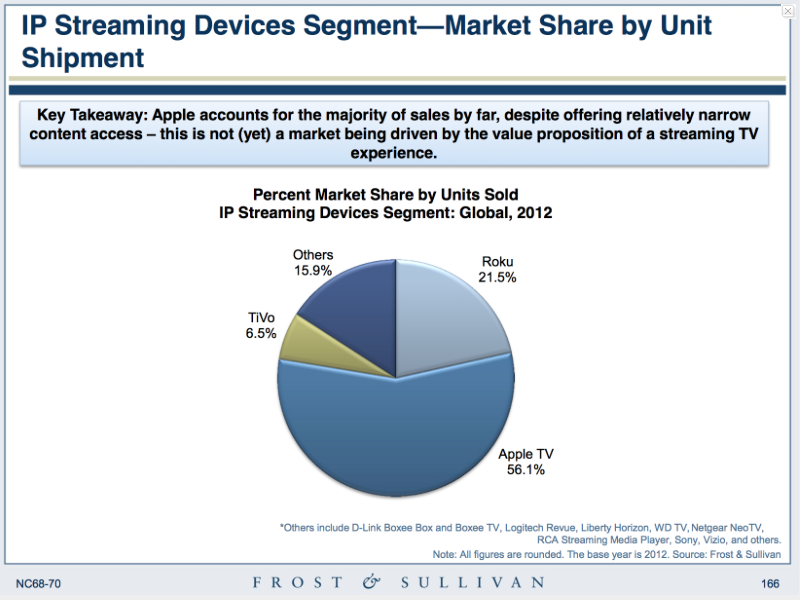Apple leads the streaming devices market ... by a lot
Although it might not be the case forever, Apple is leading the streaming media devices market with a 56 percent share — a figure that is greater than all its other competitors combined, according to a new report by Frost & Sullivan, the market research and analysis firm
Apple TV sold more than 13 million units through the first quarter of 2013. Roku took second place with 21.5 percent of the market, which Frost & Sullivan believes represents about 5 million units sold.
While brands like Roku, WD TV, Boxee and Google TV may get more headlines, all but Roku and TiVo have negligible market share in a field that is growing rapidly, the firm said.
Apple’s AirPlay is the key selling point for Apple TV over its competitors, Frost & Sullivan said. Though several companies offer a similar method of wirelessly streaming media from NAS devices or computers through the set-top box to an HDTV, Apple’s method is simpler and easier to use. AirPlay technology, the firm said, was “strategically crafted to simplify the process of transferring laptop and tablet displays to a TV screen.”
AirPlay is the only technology that is implemented throughout the eco-system of both Apple devices and third-party equipment such as receivers at the hardware level, integrating content from Macs and iOS devices seamlessly.
The category is becoming more important, the firm said, as more television viewers become “cable cutters” and use alternatives such as Netflix and mobile apps for a relatively ad-free entertainment experience.
TiVo, the renowned DVR pioneer, took third place in the survey with 6.5 percent of the market and a “strong installed base,” with the entire rest of the field having a combined 15.9 percent share.
The professional video industry's #1 source for news, trends and product and tech information. Sign up below.

“Google,” said Frost & Sullivan, “is conspicuous by its absence in this segment.”
Eric Schmidt, Google’s chairman, told reporters that by the end of summer 2012, “the majority of the televisions you see in stores will have Google TV embedded.”
Frost & Sullivan noted that “devices based on the Google TV platform have seen very little commercial success so far.”
It estimated the Google software is on less than 1 million total installed devices.
In a separate news report, TheWall Street Journal reported that Apple wants to skip the commercials in television programs, possibly substituting them with other types of programming. Under an arrangement reported by the Journal, Apple would compensate the networks for the lost revenue, but the details of the plan are unclear.
Apple, the newspaper reported, wants to offer a “premium” version of the Apple TV service that would include live and on-demand television. While cable companies and networks have thus far been reluctant to endorse any ad-skipping service, the fact that they would be compensated for it may be the key factor to get them to support the concept.
Apple has patented a technology that would automatically swap out different content during the normal commercial break. It’s possible, for example, that Apple could offer targeted trailers or short subjects, or automatically post photos from the users’ library during the breaks and simply compensate the networks for the lost revenue, though how it would make up the income is the part that Apple hasn’t revealed.
